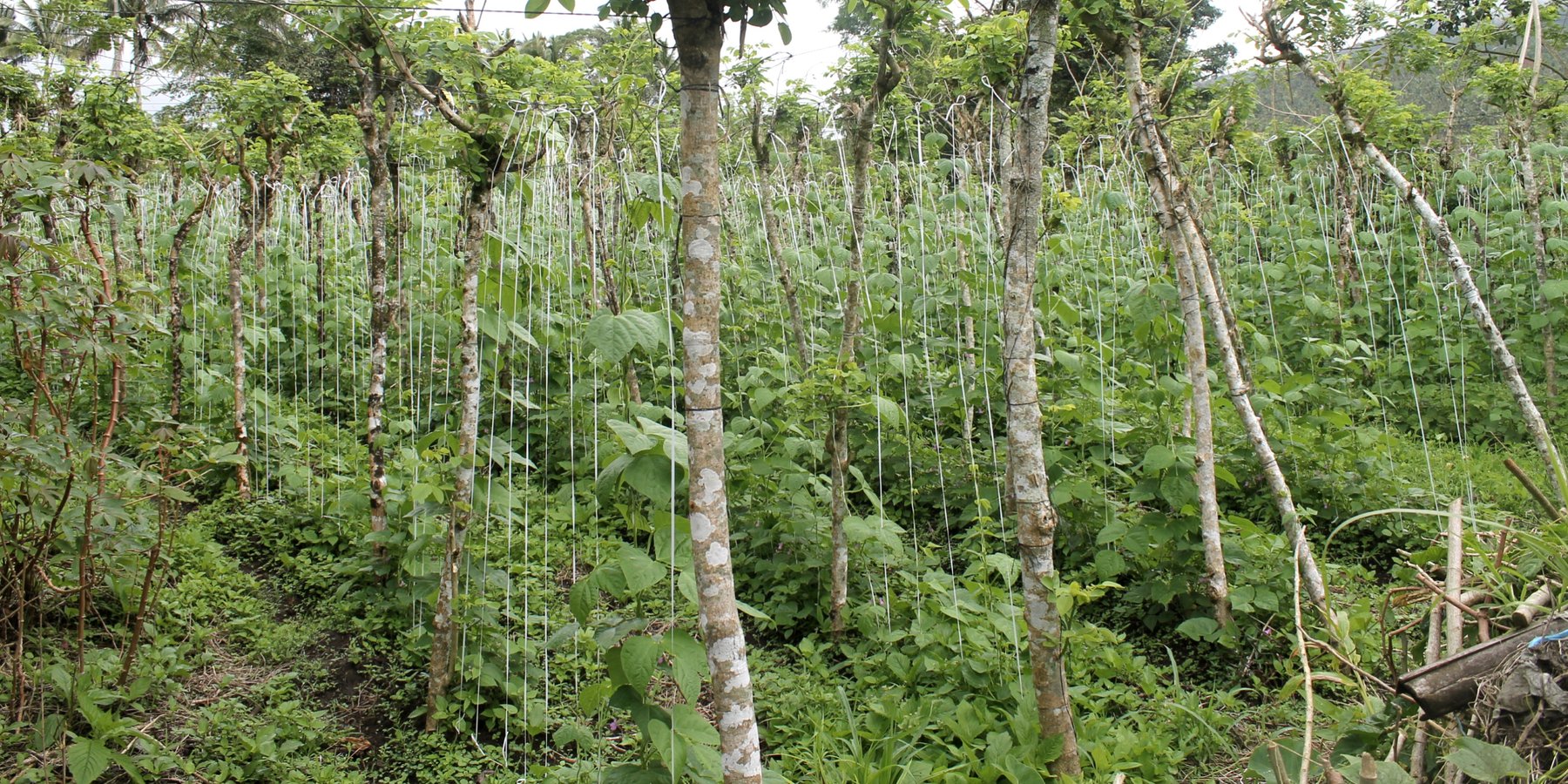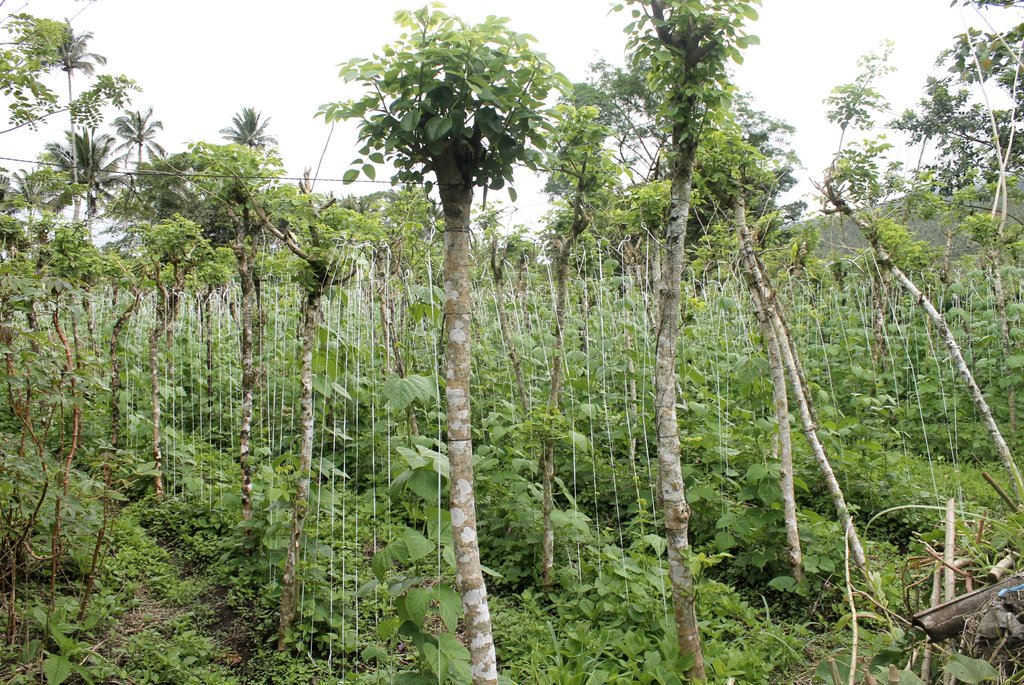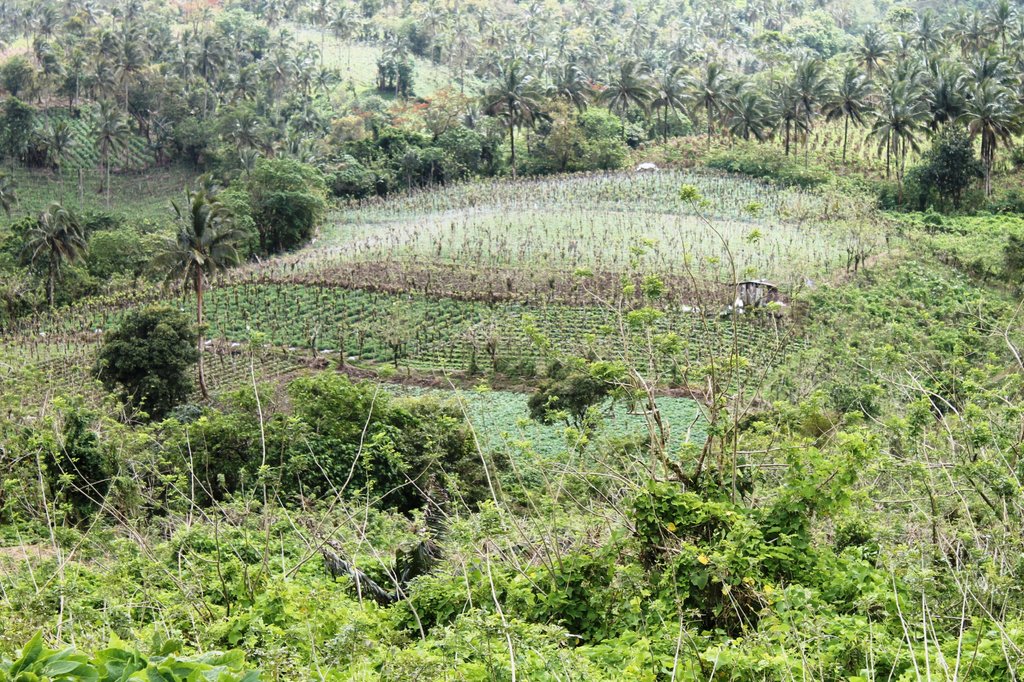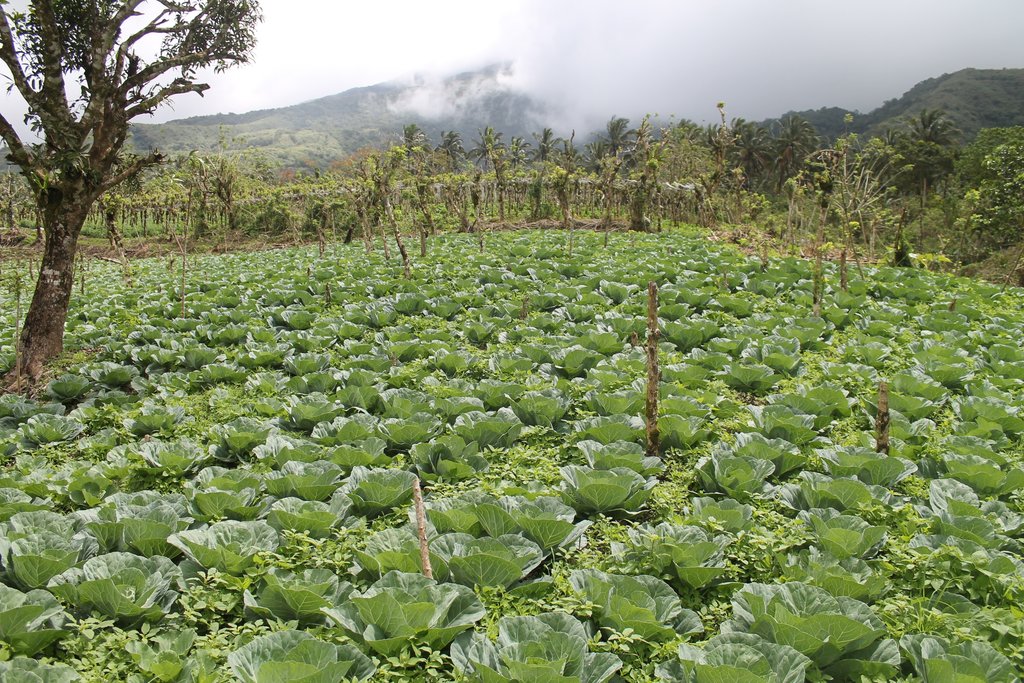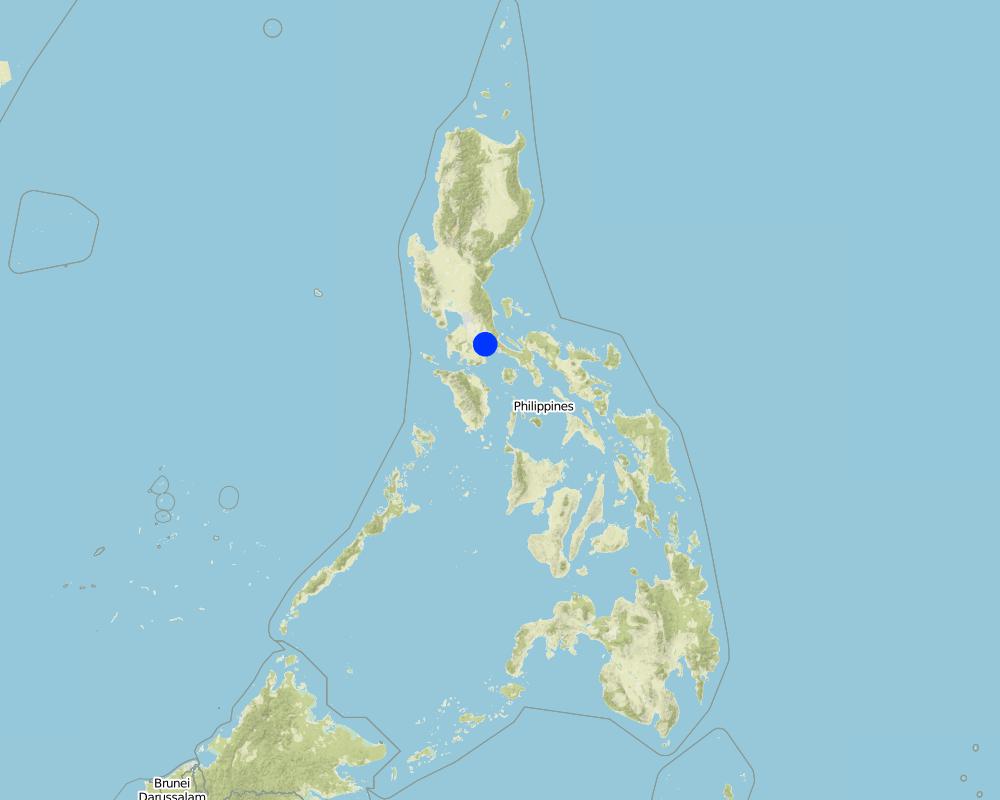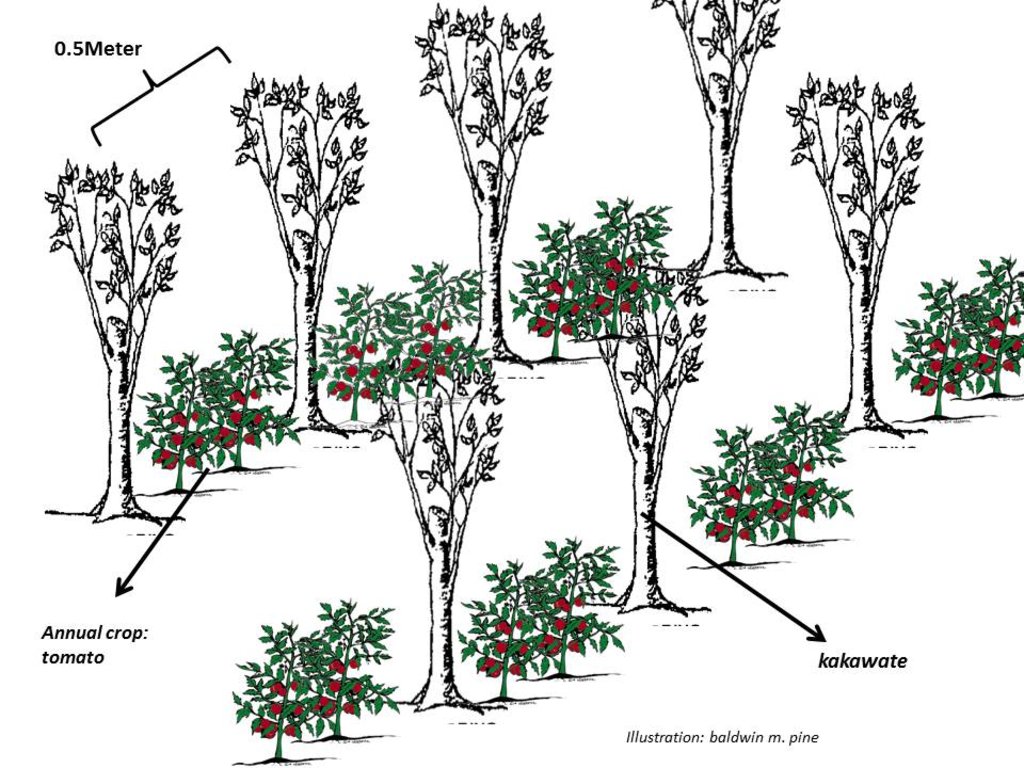Highly Diversified Cropping in Live Trellis System [菲律宾]
- 创建:
- 更新:
- 编制者: Philippine Overview of Conservation Approaches and Technologies
- 编辑者: –
- 审查者: Ursula Gaemperli, Alexandra Gavilano
Kakawate as live trellis "balag"
technologies_1930 - 菲律宾
查看章节
全部展开 全部收起1. 一般信息
1.2 参与该技术评估和文件编制的资源人员和机构的联系方式
关键资源人
土地使用者:
Urriza Girlie
菲律宾
SLM专业人员:
Dela Pena Calixto
Local Government of Nagcarlan, Laguna
菲律宾
Soil Specialist / GIS Specialist:
Pine Baldwin
Bureau of Soils and Water Management
菲律宾
Engineer:
Raquid Jemar
Bureau of Soils and Water Management
菲律宾
Engineer:
Torino Mharicar
Bureau of Soils and Water Management
菲律宾
Engineer:
Tayao Aries
Bureau of Soils and Water Management
菲律宾
有助于对技术进行记录/评估的项目名称(如相关)
Decision Support for Mainstreaming and Scaling out Sustainable Land Management (GEF-FAO / DS-SLM)有助于对技术进行记录/评估的机构名称(如相关)
Bureau of Soils and Water Management (Bureau of Soils and Water Management) - 菲律宾1.3 关于使用通过WOCAT记录的数据的条件
编制者和关键资源人员接受有关使用通过WOCAT记录数据的条件。:
是
1.4 所述技术的可持续性声明
这里所描述的技术在土地退化方面是否存在问题,导致无法被认为是一种可持续的土地管理技术?:
否
2. SLM技术的说明
2.1 技术简介
技术定义:
Gliricidia sepium locally known as "kakawate" served as live trellis / or anchorage for annual crops (mostly creeping-type vegetables) and erosion control measure. The technology is well-adopted in the community providing immediate food for the farmers and increased income due to diversified farming.
2.2 技术的详细说明
说明:
The Highly Diversified Cropping in Live Trellis System is a traditional or local farmers' initiative technology widely practiced in Brgy. Bukal, Nagcarlan, Laguna situated in the area of Mt. Banahaw. The area with rolling to hilly terrain is receiving an annual rainfall of 1000-2000 mm. Each of the farmers who practiced the technology has 0.5 to 1.0 ha production area. Moreover, the community is accessible to infrastructures such as schools and market. Soils in the area is relatively good for agriculture cultivation.
Kakawate, a small to medium-sized, thornless tree which usually attains a height of 10-12 m is being used as live trellis or "balag" to various annual crops such as tomato, cucumber, chayote, beans, and ampalaya in the community. The cropping system is highly diversified since crop rotation is being practiced throughout the year. Aside from being an anchorage for annual crops, kakawate also stabilizes sloping lands and reduces soil erosion due to its strong roots which can grow 3-5 meters laterally, thereby holding the soil firmly. They are planted in a row of approximately 2-3 meters making it more effective in preventing soil erosion. Furthermore, kakawate is being trimmed and maintained every 3-6 months or as needs arise to a approximate 3 meters high as live trellis, the trimmed leaves are very rich in nitrogen and will eventually serve as compost or crop cover. These will help in improving soil quality and moisture in the soil. In addition, kakawate has multiple uses and benefits; they can serve as hardwood or firewood when matured, as materials in making furniture and anchorage for flowering plants like orchids.
In establishing the live trellis system, kakawate trunks/or cuttings "quick sticks" with at least 2-meter height are planted in a row. An estimate of 0.5 to 1 meter planting distance within a row and also between rows is used. When the kakawate trunks are already set up and planted, they are interconnected using a metallic wires. Along these wires, plastic straws are tied in a vertical position whereby crops can utilize this straws for creeping/ climbing . Finally, the desired crop will be planted according to their cropping pattern. Maintenance of the technology includes: weeding and trimming. During infestation, application of pesticide is done but in minimal.
The technology requires manual works resulting to elimination of machines that contributes to soil compaction.
The technology has been a practice in the community for a long time, and land users continue to adopt the technology because of it's easiness and inexpensiveness to establish, and low cost in terms of maintenance activity. Adding up to this is the variety of plants to be grown, making their market more profitable.
Gliricidia normally grows in tropical countries like the Philippines and is being utilized as hedgerows for erosion control measures. Over the years, its effectiveness as erosion control is known, and an increasingly used forage crop in cut-and-carry systems.
2.3 技术照片
2.5 已应用该技术的、本评估所涵盖的国家/地区/地点
国家:
菲律宾
区域/州/省:
Laguna
有关地点的进一步说明:
Brgy. Bukal, Nagcarlan
具体说明该技术的分布:
- 均匀地分布在一个区域
如果不知道精确的区域,请注明大致覆盖的区域:
- 1-10 平方千米
注释:
Most of the farmers in the community adopt the technology
Map
×2.6 实施日期
注明实施年份:
1950
如果不知道确切的年份,请说明大概的日期:
- 50多年前(传统)
2.7 技术介绍
详细说明该技术是如何引入的:
- 通过土地使用者的创新
- 作为传统系统的一部分(> 50 年)
3. SLM技术的分类
3.1 该技术的主要目的
- 改良生产
- 减少、预防、恢复土地退化
- 保护生态系统
- 结合其他技术保护流域/下游区域
- 保持/提高生物多样性
- 降低灾害风险
- 适应气候变化/极端天气及其影响
- 创造有益的经济影响
- 创造有益的社会影响
3.2 应用该技术的当前土地利用类型

农田
- 一年一作
- 乔木与灌木的种植
年作 - 具体指明作物:
- 豆科牧草和豆类 - 豆子
- 蔬菜 - 叶菜(色拉、卷心菜、菠菜和其他)
- tomatoes
- Sayote (cf. Cucurbitaceae family), Kakawate (cf. Gliricidia sepium)
每年的生长季节数:
- 3
具体说明:
Cabbages and lettuce can be harvested three times a year.
注释:
Main crops (cash and food crops): Sayote, beans, tomato, cabbage, lettuce, Kakawate
3.4 供水
该技术所应用土地的供水:
- 雨养
3.5 该技术所属的SLM组
- 农业林学
- 改良的地面/植被覆盖
- 土壤肥力综合管理
3.6 包含该技术的可持续土地管理措施

农艺措施
- A1:植被和土壤覆盖层
- A2:有机质/土壤肥力
- A3:土壤表面处理

植物措施
- V1:乔木和灌木覆盖层
3.7 该技术强调的主要土地退化类型

土壤水蚀
- Wt:表土流失/地表侵蚀
- Wo:场外劣化效应
3.8 防止、减少或恢复土地退化
具体数量名该技术与土地退化有关的目标:
- 防止土地退化
- 减少土地退化
4. 技术规范、实施活动、投入和成本
4.1 该技术的技术图纸
技术规范(与技术图纸相关):
Kakawate cuttings are planted with an estimated planting distance of 0.5 m to 1 m. They are trimmed and maintained at around 3 meters high for every 3-6 months or as needs arise. In between the kakawate are annual crops like tomato, chayote, beans,cucumber, lettuce and cabbages which are planted in rotation depending on the season.
作者:
Baldwin M. Pine
日期:
03/03/2017
4.2 有关投入和成本计算的一般信息
具体说明成本和投入是如何计算的:
- 每个技术区域
注明尺寸和面积单位:
0.5 hectare
其它/国家货币(具体说明):
Philippine Peso (Php)
如相关,注明美元与当地货币的汇率(例如1美元=79.9巴西雷亚尔):1美元=:
50.0
注明雇用劳工的每日平均工资成本:
300
4.3 技术建立活动
| 活动 | 时间(季度) | |
|---|---|---|
| 1. | Clearing of the area | As needs arise or before planting of kakawate and annual crops |
| 2. | Planting of kakawate cuttings | |
| 3. | Installation of metal wire and plastic straws | |
| 4. | Planting of annual crop: tomato | First cropping usually from December to March |
| 5. | Planting of annual crop: cucumber or beans | After harvest of the 1st crop (tomato) usually from April to June |
| 6. | Planting of annual crop: chayote | After harvest of the second crop ( cucumber or beans) usually from July to December |
4.4 技术建立所需要的费用和投入
| 对投入进行具体说明 | 单位 | 数量 | 单位成本 | 每项投入的总成本 | 土地使用者承担的成本% | |
|---|---|---|---|---|---|---|
| 劳动力 | Manual labour: Weeding | person-days | 3.0 | 300.0 | 900.0 | 100.0 |
| 劳动力 | Manual labour: Planting | person-days | 3.0 | 300.0 | 900.0 | 100.0 |
| 劳动力 | Manual labour: Fertilizer Application | person-days | 3.0 | 300.0 | 900.0 | 100.0 |
| 劳动力 | Manual labour: Harvesting and Hauling | person-days | 3.0 | 300.0 | 900.0 | 100.0 |
| 植物材料 | Kakawate cuttings (cuttings are abundant in the area and not for sale) | 100.0 | ||||
| 植物材料 | Tomato @ 100grams per can | can | 1.0 | 1950.0 | 1950.0 | 100.0 |
| 植物材料 | Cucumber @ 100grams per can | can | 1.0 | 600.0 | 600.0 | 100.0 |
| 植物材料 | Chayote (seeds are abundant in the area) | 100.0 | ||||
| 肥料和杀菌剂 | Inorganic fertilizer: Urea | bag | 5.0 | 1500.0 | 7500.0 | 100.0 |
| 肥料和杀菌剂 | Organic fertilizer: chicken dung | bag | 5.0 | 450.0 | 2250.0 | 100.0 |
| 肥料和杀菌剂 | Pesticide | bottle | 1.0 | 280.0 | 280.0 | 100.0 |
| 施工材料 | Metal wire ( can be used for a long time, up to 10 years life span | roll | 6.0 | 480.0 | 2880.0 | 100.0 |
| 施工材料 | Straw | roll | 10.0 | 100.0 | 1000.0 | 100.0 |
| 技术建立所需总成本 | 20060.0 | |||||
| 技术建立总成本,美元 | 401.2 | |||||
4.5 维护/经常性活动
| 活动 | 时间/频率 | |
|---|---|---|
| 1. | Weeding | As needs arise but normally twice per cropping per crop |
| 2. | Trimming of kakawate | As needs arise |
| 3. | Application of organic fertilizer | Once per cropping |
| 4. | Application of inorganic fertilizer | Twice per cropping |
| 5. | Spraying of pesticide | As needs arise |
4.6 维护/经常性活动所需要的费用和投入(每年)
| 对投入进行具体说明 | 单位 | 数量 | 单位成本 | 每项投入的总成本 | 土地使用者承担的成本% | |
|---|---|---|---|---|---|---|
| 劳动力 | Weeding | person-days | 3.0 | 300.0 | 900.0 | 100.0 |
| 劳动力 | Trimming of kakawate | person-days | 3.0 | 300.0 | 900.0 | 100.0 |
| 劳动力 | Application of organic fertilizer | person-days | 3.0 | 300.0 | 900.0 | 100.0 |
| 劳动力 | Application of inorganic fertilizer | person-days | 3.0 | 300.0 | 900.0 | 100.0 |
| 设备 | Spraying of pesticide | person-days | 3.0 | 300.0 | 900.0 | 100.0 |
| 技术维护所需总成本 | 4500.0 | |||||
| 技术维护总成本,美元 | 90.0 | |||||
5. 自然和人文环境
5.1 气候
年降雨量
- < 250毫米
- 251-500毫米
- 501-750毫米
- 751-1,000毫米
- 1,001-1,500毫米
- 1,501-2,000毫米
- 2,001-3,000毫米
- 3,001-4,000毫米
- > 4,000毫米
指定年平均降雨量(若已知),单位为mm:
1500.00
有关降雨的规范/注释:
Rainfall is evenly distributed throughout the year
农业气候带
- 潮湿的
5.2 地形
平均坡度:
- 水平(0-2%)
- 缓降(3-5%)
- 平缓(6-10%)
- 滚坡(11-15%)
- 崎岖(16-30%)
- 陡峭(31-60%)
- 非常陡峭(>60%)
地形:
- 高原/平原
- 山脊
- 山坡
- 山地斜坡
- 麓坡
- 谷底
垂直分布带:
- 0-100 m a.s.l.
- 101-500 m a.s.l.
- 501-1,000 m a.s.l.
- 1,001-1,500 m a.s.l.
- 1,501-2,000 m a.s.l.
- 2,001-2,500 m a.s.l.
- 2,501-3,000 m a.s.l.
- 3,001-4,000 m a.s.l.
- > 4,000 m a.s.l.
5.3 土壤
平均土层深度:
- 非常浅(0-20厘米)
- 浅(21-50厘米)
- 中等深度(51-80厘米)
- 深(81-120厘米)
- 非常深(> 120厘米)
土壤质地(表土):
- 粗粒/轻(砂质)
- 细粒/重质(粘土)
土壤质地(地表以下> 20厘米):
- 中粒(壤土、粉土)
表土有机质:
- 高(>3%)
- 中(1-3%)
如有可能,附上完整的土壤描述或具体说明可用的信息,例如土壤类型、土壤酸碱度、阳离子交换能力、氮、盐度等。:
pH is 6.59
5.4 水资源可用性和质量
地表水的可用性:
好
水质(未处理):
良好饮用水
水的盐度有问题吗?:
否
该区域正在发生洪水吗?:
否
5.5 生物多样性
物种多样性:
- 高
栖息地多样性:
- 高
5.6 应用该技术的土地使用者的特征
定栖或游牧:
- 定栖的
生产系统的市场定位:
- 混合(生计/商业)
- 商业/市场
非农收入:
- 收入的10-50%
相对财富水平:
- 平均水平
个人或集体:
- 个人/家庭
机械化水平:
- 手工作业
性别:
- 女人
- 男人
土地使用者的年龄:
- 中年人
- 老年人
5.7 应用该技术的土地使用者使用的平均土地面积
- < 0.5 公顷
- 0.5-1 公顷
- 1-2 公顷
- 2-5公顷
- 5-15公顷
- 15-50公顷
- 50-100公顷
- 100-500公顷
- 500-1,000公顷
- 1,000-10,000公顷
- > 10,000公顷
这被认为是小规模、中规模还是大规模的(参照当地实际情况)?:
- 小规模的
5.8 土地所有权、土地使用权和水使用权
土地所有权:
- 个人,有命名
土地使用权:
- 个人
用水权:
- 个人
5.9 进入服务和基础设施的通道
健康:
- 贫瘠
- 适度的
- 好
教育:
- 贫瘠
- 适度的
- 好
技术援助:
- 贫瘠
- 适度的
- 好
就业(例如非农):
- 贫瘠
- 适度的
- 好
市场:
- 贫瘠
- 适度的
- 好
能源:
- 贫瘠
- 适度的
- 好
道路和交通:
- 贫瘠
- 适度的
- 好
饮用水和卫生设施:
- 贫瘠
- 适度的
- 好
金融服务:
- 贫瘠
- 适度的
- 好
6. 影响和结论性说明
6.1 该技术的现场影响
社会经济效应
生产
作物生产
注释/具体说明:
An increase in production due to crop diversification
作物质量
注释/具体说明:
Organic farming is a common practice in the community, and with this, it aids in the development of crop quality.
饲料生产
注释/具体说明:
Kakawate are being utilized as forage crop for ruminants in the area.
饲料质量
注释/具体说明:
Kakawate is rich in Nitrogen.
木材生产
注释/具体说明:
Kakawate when matured can be utilized as firewood and materials for making furnitures.
产品多样性
注释/具体说明:
Crop rotation makes the technology diverse.
生产区域
注释/具体说明:
The area is maximized for cultivation at a minimum soil disturbance.
土地管理
收入和成本
农业投入费用
注释/具体说明:
The application of inorganic fertilizer is minimal due to organic farming.
农业收入
注释/具体说明:
Farmers' income is increased due to crop diversicification
收入来源的多样性
注释/具体说明:
Farmers' income is increased due to crop diversicification.
社会文化影响
食品安全/自给自足
SLM/土地退化知识
注释/具体说明:
The continued adoption of the technology testifies that SLM and/land degradation knowledge is improved in the community.
生态影响
土壤
土壤水分
注释/具体说明:
Kakawate when left on the ground aids in the improvement of soil moisture.
土壤覆盖层
注释/具体说明:
Crop rotation practice improves soil cover.
土壤流失
注释/具体说明:
Over the years, kakawate is proven to be an effective erosion control measure in the sloping areas.
土壤压实
注释/具体说明:
Manual cultivation aids in minimal disturbance of the soil, thereby does not contribute to soil compaction in the area.
土壤有机物/地下C
注释/具体说明:
Organic farming is a practice in the community.
生物多样性:植被、动物
植被覆盖
害虫/疾病控制
注释/具体说明:
Crop rotation helps in the decreased of pest population.
减少气候和灾害风险
滑坡/泥石流
碳和温室气体的排放
注释/具体说明:
The technology requires manual cultivation with least or no machine intervention, organic farming is a must with minimum usage of inorganic fertilizer, and biodiversity is also encourage. With that, the technology is believed to be effective to address carbon emission and greenhouse gases.
6.2 该技术的场外影响已经显现
下游洪水
6.4 成本效益分析
技术收益与技术建立成本相比如何(从土地使用者的角度看)?
短期回报:
积极
长期回报:
积极
技术收益与技术维护成本/经常性成本相比如何(从土地使用者的角度看)?
短期回报:
积极
长期回报:
积极
6.5 技术采用
- > 50%
如若可行,进行量化(住户数量和/或覆盖面积):
Almost all of local farmers practice the technology
在所有采用这项技术的人当中,有多少人是自发的,即未获得任何物质奖励/付款?:
- 91-100%
6.6 适应
最近是否对该技术进行了修改以适应不断变化的条件?:
否
6.7 该技术的优点/长处/机会
| 土地使用者眼中的长处/优势/机会 |
|---|
|
(1) Increase farm income (2) Diverse farm produce (3) Easiness to establish, no need for technical knowledge to establish (4) Inexpensive (4) Organic farming |
| 编制者或其他关键资源人员认为的长处/优势/机会 |
|---|
|
(1) Low production cost (2) Easiness to maintain (3) Effective erosion control measure (4) Increase farm yield and income (5) Diverse farm produce (6) Easiness to transfer |
6.8 技术的弱点/缺点/风险及其克服方法
| 土地使用者认为的弱点/缺点/风险 | 如何克服它们? |
|---|---|
| (1) Pest infestation | (1) Pesticide application |
| 编制者或其他关键资源人员认为的弱点/缺点/风险 | 如何克服它们? |
|---|---|
| (1) The technology is very good in terms of erosion control and improving lives of farmers in the community, but then the technology is not well-known for the whole country. | (1). The WOCAT database as an excellent information tool /or medium in the dissemination of this kind of technology, not only within Philippines but all over the world. These would highlight initiatives of the local farmers situated in remote areas in terms of managing the land productively and sustainably. |
7. 参考和链接
7.1 信息的方法/来源
- 实地考察、实地调查
Two infomants: Local Government Unit (LGU) technical staff and the land owner
- 与土地使用者的访谈
Two infomants: LGU technical staff and the land owner
- 与SLM专业人员/专家的访谈
One LGU technical staff
(现场)数据是什么时候汇编的?:
03/03/2017
链接和模块
全部展开 全部收起链接
无链接
模块
无模块


